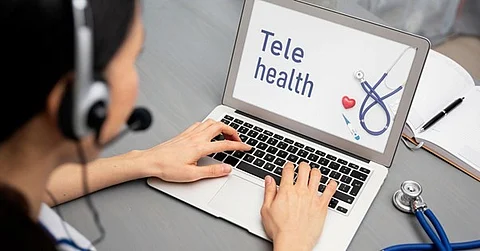

The demand for efficient clinical workflows is paramount in today's fast-paced healthcare environment. The rise of telehealth technology, particularly after the COVID-19 pandemic, has transformed patient care delivery, enabling providers to manage larger caseloads while improving patient engagement and satisfaction. Telehealth technology is reshaping traditional workflows, offering solutions to streamline clinical processes, reduce overhead costs, and minimize the burdens of time and resource constraints on healthcare providers.
Telehealth allows for the seamless integration of remote patient care, facilitating everything from virtual consultations to remote monitoring while ensuring the quality of care remains high. The flexibility and scalability of telemedicine app development solutions are helping providers enhance clinical workflow, allowing healthcare systems to meet the growing demand for accessible, efficient, and comprehensive care. This article explores various ways telehealth technology enhances clinical workflows, supporting healthcare providers and patients.
Traditionally, patient intake involves multiple steps, including form filling, documentation, and sometimes lengthy wait times. Telehealth platforms can automate this process by allowing patients to complete intake forms, upload documents, and verify insurance information online. This reduces the need for in-person interactions and eliminates paperwork errors and delays.
By automating patient intake, telehealth technology can save patients and administrative staff time. Many telehealth platforms offer pre-visit assessments, which allow patients to answer screening questions or upload photos of medical records, lab results, or prior scans before an appointment. This pre-assessment can assist healthcare providers in better preparing for the patient’s virtual visit, ultimately enhancing clinical efficiency and ensuring that the visit time is focused on delivering care.
Scheduling and managing appointments can be time-consuming, often leading to appointment overlaps, no-shows, or last-minute cancellations. Telehealth technology integrates scheduling tools that allow patients to book appointments at their convenience and automatically send reminders via text, email, or app notifications.
Automated scheduling systems also allow healthcare providers to set up waiting lists or reschedule canceled appointments efficiently, reducing downtime and maximizing productivity. Some telehealth platforms can send multiple alerts or even facilitate a quick check-in before the appointment for patients who may miss a reminder. This scheduling automation ensures that clinical workflows remain uninterrupted and minimizes lost time, optimizing the clinician’s schedule and resources.
Telehealth platforms provide tools for virtual triage, allowing patients to complete an initial screening from home. This virtual triage process uses AI-driven questionnaires to assess symptoms and guide patients on the urgency of their care needs, allowing providers to prioritize cases efficiently. By filtering non-emergency cases from high-priority ones, telehealth technology ensures that healthcare providers focus their time on patients who need immediate attention.
With virtual triage, healthcare teams can allocate resources more effectively and reduce congestion in emergency departments. This pre-appointment screening streamlines the clinical workflow, helping to ensure that patients are directed to the right specialist or department, further improving care efficiency.
Remote Patient Monitoring (RPM) is a telehealth technology that enables continuous monitoring of patient health data outside the clinical setting, such as heart rate, blood pressure, glucose levels, and more. RPM devices and apps automatically collect data and send it to healthcare providers, offering real-time insights into a patient's health condition without frequent in-person visits.
RPM empowers patients to manage their health proactively and enables healthcare providers to detect any concerning changes early on. By accessing continuous patient data, clinicians can identify trends, adjust treatment plans as necessary, and intervene before a condition worsens. This capability significantly enhances workflow by reducing the need for regular in-person checkups and improving patient outcomes through early intervention.
Telehealth technology often integrates with Electronic Health Record (EHR) systems, enabling seamless data transfer between virtual consultations and patient records. Integration with EHRs eliminates the need for double entry, saving time and reducing the risk of errors in documentation. Physicians and care teams can access comprehensive patient data directly within the telehealth platform, facilitating informed decision-making during consultations.
By allowing quick access to EHRs, healthcare providers can instantly view a patient’s medical history, lab results, and previous diagnoses, thereby eliminating the need for paper charts or separate systems. This integration streamlines clinical workflows, ensuring that healthcare teams can quickly access relevant information and focus more on patient care.
Effective follow-up care is essential for managing chronic diseases and ensuring patients adhere to treatment plans. Telehealth platforms make it easy for healthcare providers to conduct follow-up consultations and monitor patient progress remotely. Virtual check-ins reduce the need for in-person visits, making follow-up more accessible and convenient for patients, especially those with mobility issues or transportation barriers.
In chronic disease management, regular follow-ups are critical. Through telehealth technology, providers can quickly assess patient compliance, answer questions, adjust treatment as necessary, and provide education to help patients manage their conditions better. By enhancing follow-up care, telehealth improves clinical workflow efficiency and supports continuity of care, ultimately improving patient outcomes.
Integrating telehealth technology into healthcare systems has fundamentally transformed clinical workflows, offering a new level of efficiency, flexibility, and patient-centered care. From virtual triage and real-time monitoring to streamlined scheduling and seamless communication, telehealth enhances every stage of the clinical process.
By embracing telehealth technology, healthcare providers can reduce administrative burdens, increase productivity, and focus more on delivering high-quality care. The evolution of telehealth technology promises an era of improved healthcare delivery, meeting the demands of modern patients and making healthcare more accessible, efficient, and effective.
